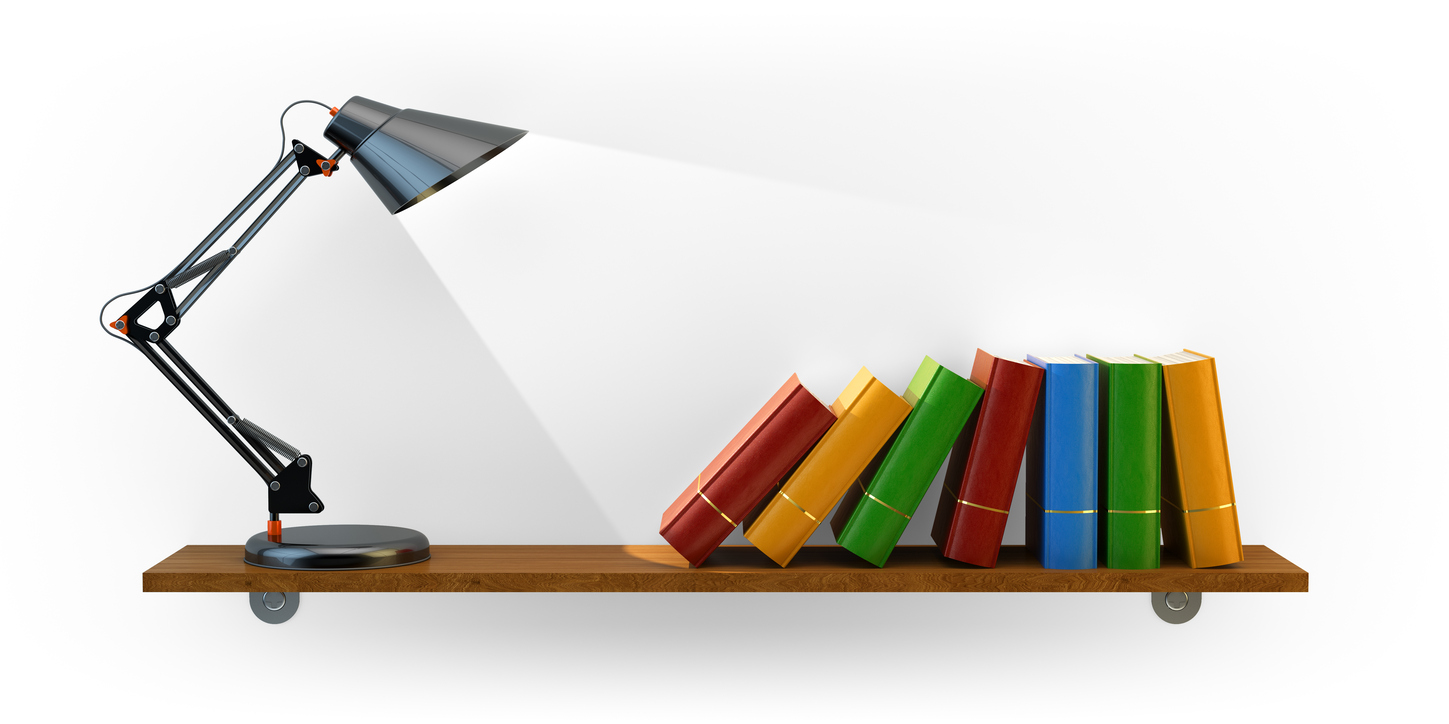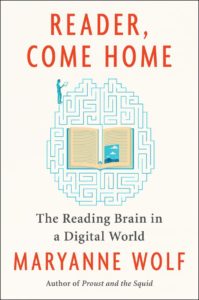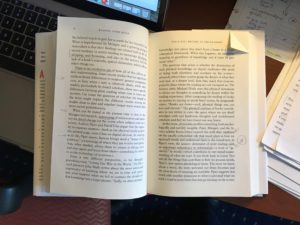What are you doing, right now? Are you reading this blog post in your first language, or one of your first languages? Did you print this to read? Most likely, you’re reading on a mobile screen. As you recognize the shapes of letters, and the first few letters of each word, your brain will fill in the rest. That happens with full sentences, too. If you are reading on a screen, you’re likely reading in a pattern (maybe the Z pattern, or the F pattern) that will guide you in prioritizing the first set of information, sweeping down through the body of the text to “word spot” in grabbing context and capture some details, and then head to the end.

MaryAnne Wolf’s Reader, Come Home: The Reading Brain in a Digital World (2018) returns after 10 years to map a cognitive landscape that was only beginning to take shape in her earlier book, Proust and the Squid: The Story and Science of the Reading Brain (2008). Like Naomi Baron, whose Always On: Language in an Online and Mobile World was published in 2008 and Words on Screen: The Fate of Reading in a Digital World appeared in 2015, Wolf was a literary scholar first and became captivated by the study of language in action. In Baron’s case this meant a PhD in semiotics; in Wolf’s, in cognitive neuroscience. The challenge and the passion they share from different disciplinary perspectives and grounding, though each is extraordinarily creative in their multidisciplinary approach, is for reading. What is reading, and what is happening to reading?
These are historical as well as scientific questions, for reading itself is a highly politicized and romanticized activity. Cathy Davidson is another literary scholar who now works in education and technology; her 1986 Revolution and the Word: The Rise of the Novel in America sketched the anxiety (even hostility) of early American elites to the increasing variety and availability of novels, and what kind of awful ideas they might implant in their readers, especially women. Harvard scholar Leah Price, who met literature and never left it, is about to publish Overbooked: Dispatches from the Front Lines of the Reading Wars, which argues that an embrace of ever more accessible print, and its unique capacity to edify and refine individual readers and the body politic, is an artifact of the Victorian era.
In other words, might the digital revolution be another example of anxiety about new modes of communication? The angst associated with novels, for example, and the cultural degradation they engendered, could fill books. Actually, it already does fill scholarly analyses. But Wolf and Baron seem to have something else to hand, namely scientific study of what happens when the brain meets this fundamentally humanistic endeavor: literacy.
In Reader Come Home Wolf is looking to understand how our brains might be adapting to a new type of reading, and the implications for individuals and societies. The book is a combination of engaging synthesis of neuroscience and educational research, with reflection on literature and literary reading. Wolf’s nine chapters are styled “letters” to her reader. The first is about the new demands on the reading brain from the digital information explosion, followed by a closer look at the neuroscience of reading and the significance of neuroplasticity for adaption to digital texts. She spends several chapters on the current state of thinking about how children should be introduced to literacy, weighing the benefits of print versus digital presentation, and recommends developing a “biliterate brain,” capable of working in both registers. Finally, she worries about the social and political costs of the scattered attention and the superficial skimming for information that seems to characterize reading in the twenty-first century.
 The human brain was not designed for reading, a relatively late evolution that draws on core functions such as Vision and Language. (Nor was the eye, a fact I am reminded as mine grow increasingly weak from so much of it.) That neuroplasticity allows for such “genetically unplanned for activities” is incredible enough; the sheer variety of reading circuitry is made possible through plasticity, new cellular activity and specificity and networking. Reading incorporates “input from two hemispheres, four lobes in each hemisphere…and all five layers of the brain.” Wolf illustrates the brain function required for reading through the metaphor of the circus, with intense and complex activity happening in multiple arenas of Vision, Language, and Cognition at once. The circus spotlights, to take one example, are the attention paid to each part of the reading process, for example helping us to disengage from one task, move to another, and then focus on the new task. In the reading brain “as many things are happening in zigzagging, feed-forward, and feed-backward interactivity as are occurring linearly.”
The human brain was not designed for reading, a relatively late evolution that draws on core functions such as Vision and Language. (Nor was the eye, a fact I am reminded as mine grow increasingly weak from so much of it.) That neuroplasticity allows for such “genetically unplanned for activities” is incredible enough; the sheer variety of reading circuitry is made possible through plasticity, new cellular activity and specificity and networking. Reading incorporates “input from two hemispheres, four lobes in each hemisphere…and all five layers of the brain.” Wolf illustrates the brain function required for reading through the metaphor of the circus, with intense and complex activity happening in multiple arenas of Vision, Language, and Cognition at once. The circus spotlights, to take one example, are the attention paid to each part of the reading process, for example helping us to disengage from one task, move to another, and then focus on the new task. In the reading brain “as many things are happening in zigzagging, feed-forward, and feed-backward interactivity as are occurring linearly.”
Though she spends considerable, and considerably interesting, space on the neuroscience, Wolf’s heart isn’t in the brain itself, but in the connection of brain to heart and soul. Her third “letter” on deep reading is the key to concerns about the disruptions of the digital world. “Deep Reading” is beyond the “simple additive exercise in which all the perceptual and linguistic activities described earlier in the [circus] rings now take place for twenty [or more] words in a row.” Moving from “perception to comprehension” is evocative, and analytical. We feel, and we think, and we understand. And then we question, and understand anew. It is the deepest, empathetic acts of humanity to understand others and other perspectives, something Wolf (and the many champions of humanistic thinking she quotes) connects to the extraordinary act of reading.
“I think that reading, in its original essence, [is] that fertile miracle of communication effected in solitude….We feel quite truly that our wisdom begins where that of the author leaves off.”
Marcel Proust, On Reading (quoted in Wolf, Reader, Come Home)
As a good literary scholar, Wolf revels in reading the work that has shaped her own thinking, and which she felt extended her mind and thus her experiences. She waxes nostalgic about the importance of the complex sentence structure in nineteenth and early twentieth century novels, citing a circuitous passage from George Eliot’s Middlemarch about the circuitous “aimless meanderings” of Mr. Causubon’s own mind as an exemplar. There is no bleaker summary of our current, inattentive style, in which there seems little room for such meanderings, than tl; dr.
“For the prose writer: success consists in felicity of verbal expression, which every so often may result from a quick flash of inspiration but as a rule involves a patient search for the mot juste, for the sentence in which every word is unalterable, the most effective marriage of sound and concepts…concise, concentrated and memorable.”
Italo Calvino, Six Memos for the Next Millennium (quotes in Wolf, Reader, Come Home)

Is tl; dr partly a function of the medium? Wolf makes an impassioned case for the value of ink on paper, and although the science on this is not unambiguous, it does suggest that digital reading is a different kind of reading. This is what Baron was getting at in Words on Screen. Books are objects, and their materiality may be a key part of their success as an information technology. The role of touch in the multi-sensory experience of reading turns out to be as important as we intuit it to be when we hold a volume or turn a page — or better yet, when we mark it up. Book historians have long looked to the way we add our own marking to print as a cultural and historical indicator. Davidson’s analysis of the power of novels was based in part on the signatures claiming ownership and the marginalia indicating engagement with the text. As Wolf notes, citing Andrew Piper’s Book Was There: Reading in Electronic Times, “the sensory dimension of print reading adds an important redundancy to information — a kind of geometry to words — which contributes to our overall understanding of what we read.”
Studies are less sure about how digital reading is different, though respondents generally note that they feel they read more quickly and less carefully on screen than with paper. Research is conflicting about whether comprehension is degraded by digital text, with some showing no difference and others showing significant differences. Baron has recently reported the beginning of a broader study about digital versus print in terms of student preferences and performance which also summarizes these studies. A top line finding is that 80% of students surveyed preferred print when the costs were comparable, and 92% reported their concentration was improved with print. But given cost and portability, there were clear advantages to digital, too. What might be most important is the expectations that readers bring to these difference technologies. Students seemed to expect to spend more time and be more engaged by print, and so perhaps they are. Whereas they and we fully understand the minuscule attention spans that our digital world encourages. What Linda Stone called “continuous partial attention” is the result of constant stimulation and an effort to consume information without the next level processes of full comprehension and analysis.
For scholarly communications these are not small questions. The fate of the scholarly e-book (for another post, my travails of attempting to even acquire, let alone to “read” the mangled bits of text that appear on screen, regurgitated through the teeth of various vendor platforms) and the ways we have consciously designed it not to be read, but to be searched, and stripped suggests we have a notion already about what we want the digital to deliver. The JSTOR project to “Reimagine the Digital Monograph” contended with many of these challenges (if not the love of a long George Eliot passage on paper). Mostly the conclusion seems to be that print and digital will each have their place, that we will add new technology (digital) and not take away the old (print).
Yet there are resource implications and investment decisions being made all the time that for the most part are emphasizing digital transition. Digitizing long form has meant creating small, searchable pieces for extracting information/ data, rather than for ease of reading. Or even for encouraging reading. I hear a lot from scholarly communications professionals in all fields that values are imperative to practice. Wolf is arguing that we should value reading, because in doing so we value critical engagement. Wulf agrees.
Discussion
18 Thoughts on "Dear Reader, Are You Reading?"
Really, very impressive and informative article, thank you very much for sharing such excellent efforts.
Regards,
Emad
Fiddle or bust The folk at COPE should take note of your Calvino quotation: “For the prose writer: success consists in felicity of verbal expression, which every so often may result from a quick flash of inspiration but as a rule involves a patient search for the mot juste, for the sentence in which every word is unalterable, the most effective marriage of sound and concepts…concise, concentrated and memorable.” Having found the mot juste and a string of sentences with every word unalterable, one naturally wants to repeat it in one’s future writings. Wham! The antiplagiarism software picks it up and an editor insists that you to fiddle with the paragraph to bring it below the detection threshold. Yes, the ultimate aim is effective communication, but, sorry dear author, either fiddle, or go elsewhere with your stuff!
Dear Forsdyke, your assertion is discouraging, because it is smart and true. Sincerely, Horacio Lombardi
This is true. Thank you.
Dear Karin,
I appreciate, that you put this important theme on stage. There is another impressive new article about the distinct effects of reading print and digital by Pablo Delgado et al.: Don’t throw away your printed books: A meta-analysis on the effects of reading media on reading comprehension (https://doi.org/10.1016/j.edurev.2018.09.003). The differences are of high importance likewise for authors, publishers, libraries and readers. May be nobody may need in future articles printed in journal volumes or conference proceedings. And of course there is additional value for digital texts regarding ubiquity, text mining, distant reading, skimming and consultation. But there are features of the printed monograph we couldn’t neglect, when we want to attain the full attention and awareness of readers and the best results for the learners, and look for the best service of libraries. The promise, that e-only could save money in the libraries will probably not fulfill, when we still want to serve at the patrons best. But of course libraries don’t have to offer for all products both, digital and print.
Best wishes from Germany
Rupert
There is quite a lot of fresh research on reading, most of it divided between assessing preferences and comprehension. I think Baron actually does the best job of summarizing it (in _Words on Screen_ and in the more recent article I linked to). But the challenges seem two-fold. One is we don’t know whether we are still assessing humans who have a sense of the cultural value of print (it indicates serious reading, is one shorthand) and the other is we don’t know if the (not unambiguous) indication that superficial reading on screens is a short or long term affect. Will we learn to read deeply on screen? I don’t know, obviously, any more than the people who are studying this very seriously. But I do know that researchers and publishers and libraries should be thinking hard about how to facilitate serious reading– and how that might in fact be fundamentally different than offering information.
A great post! But ironically, it seems a key noun got mangled, in “There is no bleaker summary of our current, inattentive style, in which there seems little room for such meanderings, than tl; dr.” and then “Is tl; dr partly a function of the medium?” Would love to know what ‘tl; dr.’ stands for!
“Too long; Didn’t read.” I was wondering about defining that abbreviation in the text, but figured it was pretty well known by now. I’ll go back and add that in, thanks!
Yes, as David says it means “too long; didn’t read.” Tl; dr is an abbreviation that Wikipedia says is an editorial notation to encourage concision (eg, cut the extra verbiage), but that I get in texts from my kids or see in social media all the time. David’s probably right to add the clarification, but I sort of liked that you’d have to look it up! I bow to the Editor though, as all writers should. : )
The mentioned extensive meta-analysis of empirical studies from Delgado (2018) can’t show any indications that people are developing skills for deep reading on screens or mobiles or that the native digitals are having better skills for doing so. And I agree, libraries are also for study (and also imagination) and not only for information. I respect authors choosing the printed book for reaching their goals.
Will Self has a feature in the October issue of Harper’s Magazine about this topic and it is an entertaining read. https://harpers.org/archive/2018/10/the-printed-word-in-peril/
He sides with the research conclusions that reading digitally does in fact reconfigure our brains, and suggests that these changes may be heritable, “Behold! The age of Homo virtualis is quite likely upon us…”
There is a lot of angst about the passing of print! I really loved this piece by designer/ thinker Craig Mod in Aeon about the future of reading: https://aeon.co/essays/stagnant-and-dull-can-digital-books-ever-replace-print
I would have said hands down that I barely remember anything I read digitally, but now I highlight as I read and tag things that I may need to find later. That selection process makes all the difference. https://hyp.is/5cURDtb2EeiK-7fteRiwjQ/scholarlykitchen.sspnet.org/2018/10/23/dear-reader-are-you-reading/
I do digital tagging too, and definitely appreciate the tech (like Hypothes.is! And Zotero, and others) that make that easy for me. But there’s nothing like what my spouse thinks of as making a mess in a book. Marginal notes, even though I usually only return to the ones I’m teaching from, make it stick. It seems the key finding, of the research and the projects like JSTOR’s, is that print and digital do different and complementary things and that we ought to exploit that complementarity rather than look for one to do everything.
My husband is an English professor. If I go missing, I’m trapped under a fallen stack of either his books for class or my pile of pending thrillers! Each format in its time and place!
10 years ago in trade publishing we thought the transition from print to eBooks was like going from vinyl to compact disc—one format replacing another. I’ve sometimes said that a better analogy is that it was more like going from vinyl straight to spotify. Karin’s essay suggests it’s even deeper than that. Digital reading is a meaningfully different act than print reading. This is probably a more profound distinction in scholarly publishing than, say genre fiction, and reinforces an idea that has been becoming more clear to me—that we need to assume deep readers are frequently engaging with the same book in both print and digital formats at different stages.
“Angst”, “Anxiety”, “passion”, I’m just surprised that climate change wasn’t thrown in, however, a brief search on Oxford University Press for Cathy Davidson’s book, did reveal a title on attitudes and realities (?) of climate change in early America! Please, make it stop!
As for your claim that the human brain wasn’t made for reading, it probably wasn’t ‘made’ for a lot of things but its incredible flexibility and adaptability makes many things possible and available including really valuable things like looking at a ‘device’ half the day.


